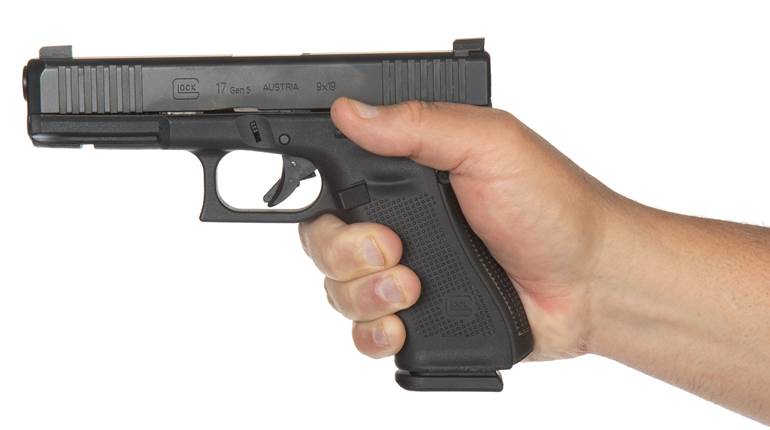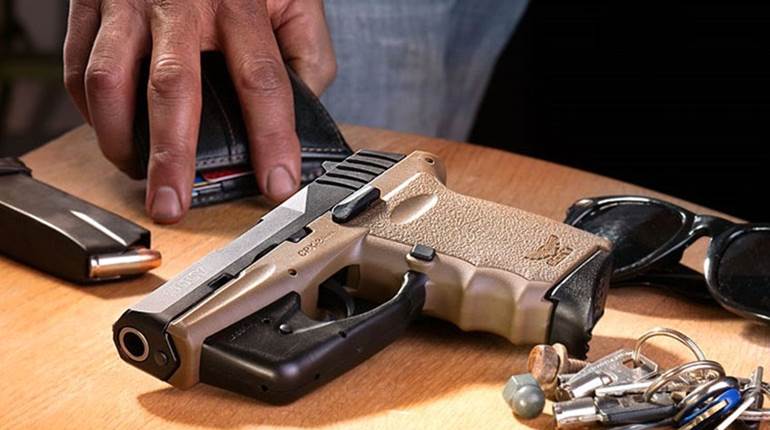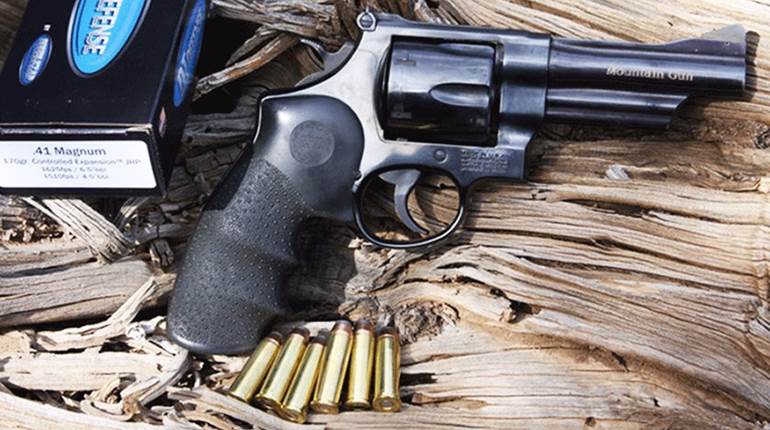
10/22/2012
The story of the .38 Super cartridge starts in 1900 when Colt introduced the John Browning-designed Model 1900 .38 Automatic pistol. Interestingly, that was two years prior to the introduction of the 9 mm Luger/Parabellum. Both utilize a 0.355-inch-diameter bullet and are ballistically very similar in performance. The 9 mm Luger was almost immediately adopted by the German military but the .38 Automatic Colt Pistol (ACP) was rejected by the U.S. military, which ultimately adopted the .45 ACP cartridge and the Colt Government Model in 1911.
In 1929, Colt tried again with an improved version of the .38 ACP offered in its M1911 pistol, which had gained fame during World War I. The improved cartridge had a new name—.38 Super—and the improvement amounted to nothing more than the cartridge being loaded to a higher pressure level—36,500 p.s.i. as compared to 26,500 p.s.i. This resulted in a velocity increase of about 200 fps, which allowed the .38 Super to outperform the 9 mm Luger. The +P designation was added to the .38 Super in 1974 to further distinguish it from the older .38 ACP. The full name is properly .38 Super Automatic +P, often abbreviated to simply .38 Super +P.
Some mistakenly assume the .38 Super was based on the 9 mm Luger and that the cases are similar; however, bullet diameter is their only similarity. The .38 Super +P case is semi-rimmed and smaller in diameter, but longer, than the 9 mm Luger case. However, the Sporting Arms and Ammunition Manufacturers’ Institute’s (SAAMI) established maximum average pressures (MAP) for these cartridges are similar at 36,500 p.s.i. for the .38 Super +P, 35,000 p.s.i. for the 9 mm Luger and 38,500 p.s.i. for the 9 mm Luger +P. From a velocity standpoint the cartridges are also very similar, but the .38 Super +P has a slight edge.
Most load manuals list only standard-pressure 9 mm loads that will propel 115-grain bullets to around 1,200 fps. By comparison, it’s easy to find safe handloads capable of driving a 115-grain bullet in excess of 1,300 fps from a .38 Super +P. Factory 9 mm +P loads, such as those from Buffalo Bore, can be found to equal .38 Super +P handload velocities. By the same token, Buffalo Bore’s .38 Super +P loads are even faster.
All differences and similarities aside, the .38 Super was only marginally successful in the States. But in countries where civilian ownership of military cartridges—such as the 9 mm Luger—are prohibited, it gained quite a following. All that changed about 30 years ago, largely due to the efforts and successes of practical pistol competitors led by Rob Leatham.
In IPSC pistol competition there’s a power factor that must be met. The power factor is established by multiplying a cartridge’s bullet weight in grains by its actual, chronographed muzzle velocity then dividing the product by 1,000. At the time, 175 was the lower limit for major power factor. (Currently, it is 165 for IPSC.) Competing with a “major” pistol was a huge advantage because B and C zone hits were worth an additional point. By using a barrel with a supported chamber in an M1911, competitors found they could indeed make major with the .38 Super +P. A by-product of that was the generation of a lot of gas, and even though the recoil with a .38 Super +P loaded to major was about the same as a .45 ACP, pistols equipped with compensators benefited from the additional gas produced, thus reducing muzzle rise and recoil.
For a time, the .38 Super was the king of practical pistol competition and custom M1911 pistolsmiths were busy building what came to be called “race guns” for this sport. The “competition” label applied to the .38 Super +P actually had a negative effect on its appeal for defensive use. That was partly because ammunition manufacturers focused on target loads for the cartridge. The trend continues today with only a handful of defensive jacketed hollow-point loads available for the .38 Super +P, and most are from boutique ammunition manufacturers, such as Buffalo Bore and Wilson Combat.
As an example, one major online supply house lists only 14 of what could be considered defensive loads for the .38 Super +P. As a comparison, it currently catalogs 97 9 mm Luger loads specifically designed for self-defense. Defensive ammunition for the .38 Super +P and the 9 mm are priced similarly but 9 mm practice ammunition can be purchased for half the price of .38 Super +P.
Availability of guns chambered for .38 Super +P continues to be limited with most being of the M1911 configuration. Even those options are dwindling, as Kimber and Para-Ordnance dropped the chambering. Armscor/Rock Island, Colt, EAA and Legacy Sports are about the only companies offering new, non-custom, .38 Super +P options today. With the unprecedented rise in concealed carry interest and the demand for ever smaller and more powerful handguns, the stage is set for the .38 Super +P to make a comeback. Its ballistic advantage, although slight, over the 9 mm Luger, helps the .38 Super +P deliver better terminal performance from short-barreled handguns.
Still, it’s unlikely the .38 Super +P will ever reach the popularity of the 9 mm Luger, the .45 ACP or even the .357 SIG which, interestingly, duplicates .38 Super +P performance. Thanks to Les Baer and Wilson Combat, you can still get a finely crafted pistol in .38 Super +P that is compact enough to carry on a daily basis. Combine one of these handguns with high-performance ammunition and you have a potent personal protection sidearm.
10/22/2012
Wilson Combat Sentinels are arguably the smallest and lightest M1911s available. Though they are built around a 3.5 inch as opposed to the 3-inch barrel found on many compact M1911s, Wilson Combat’s Sentinel M1911s have a grip frame which is about 1/4-inch shorter than those used by Colt on its Officer’s Model and by Kimber on its Ultra-size pistols. Match that short barrel and reduced grip size with a frame built of aluminum, and you end up with a very compact and lightweight handgun.
Typically, M1911s with barrels shorter than 4 inches have a reputation for less than stellar reliability. Apparently, that reputation was built without consideration of the small guns built by Wilson Combat. The Super Sentinel digested every load it was fed without a single hitch either from the bench or when conducting tactical drills. Even my 12-year-old son pushed 50 rounds through the pistol without issue.
Surprisingly, the recoil was not unbearable, even with full-power loads. The high swept grip safety, 30-l.p.i. hand-checkering on the frontstrap, bobbed grip and melding of the pistol’s edges undoubtedly contributed to its ergonomics during carry and when pulling the trigger. The Super Sentinel is also fitted with thin, G10 stocks, and even with large hands I found them very comfortable.
This pistol was easily drawn from a Galco Avenger holster and I had no trouble running the Forty Five Drill without a miss in under five seconds. In fact, even though the pistol was 37 percent lighter than the Les Baer Stinger, my times on the Forty Five Drill averaged only about a half second longer. This could be due in part to the very fast and easy to acquire, green fiber-optic front sight mated with the Wilson Combat rear Battlesight. This sight combination proved beneficial when speed shooting but was a bit more difficult for me to apply during accuracy testing at 25 yards. Still, an accuracy average of less than 2.5 inches at 25 yards is commendable from a pistol of its size.
Other features include; all over Armor Tuff coating, serrations on the top of the carbon steel slide, Browning Hi-Power-style carry cuts on the slide’s front, a seriously melted left side thumb safety, recessed slide stop pin, full-length guide rod and contoured magazine well. There is also a stainless, ramped, coned barrel, and both the barrel and chamber are fluted. The Super Sentinel comes with a 1.5-inch accuracy guarantee at 25 yards. I have no doubt the pistol is capable of that, though I am fairly confident I am not.
Manufacturer: Wilson Combat; (800) 955-4856; www.wilsoncombat.com
Caliber: .38 Super +P
Action Type: recoil-operated, semi-automatic, center-fire pistol
Frame: aluminum
Finish: Black Armor Tuff (color options available)
Barrel: 3½" (stainless steel, coned, ramped)
Rifling: five-groove, 1:16" RH Twist
Magazine: eight-round-capacity detachable box
Sights: Wilson Combat Battlesight with green fiber-optic front (other options available)
Width: 1.3"
Height: 4.8"
Overall Length: 7.2"
Weight: 25 ozs.
Grips: G10 Slimline Grips
Trigger: single-action; 3-lb., 12 oz. pull
Accessories: one spare magazine, rug
Price: $3,875 (base)
10/22/2012
Les Baer Custom has been offering finely tuned M1911 handguns for almost 20 years. It has a reputation for producing very accurate M1911s that are flawless in fit and finish. The .38 Super Stinger is one of many models offered. The Stinger uses what Les Baer calls a “Comanche top end,” which is a Commander-size slide with a 4.25-inch barrel. The grip frame is shortened like the Colt Officer’s model. The result is the marriage of two very desirable M1911 components that are rarely mated together, producing what many consider to be the ultimate “carry-size” M1911.
For the .38 Super Stinger, Les Baer uses a steel frame with the frontstrap checkered at 30 lines-per-inch (l.p.i.). The pistol is fitted with an upswept grip safety with a raised pad to help with disengagement. The magazine well is slightly beveled to assist with smooth reloads, and there’s a finely tuned Les Baer Speed Trigger with an advertised pull weight of 4 pounds. The ambidextrous safety is nicely contoured and slim on the left side so it will not aggressively bite the first knuckle of the shooting hand, and fully checkered, nicely figured, cocobolo stocks round out the frame.
The Comanche slide has highly polished sides with a matte finish on top. Tightly spaced, angled slide serrations are positioned at the rear of the slide, which is engraved with “BAER Custom” on the right and “38 SUPER” on the left. The 4350 steel, ramped, match-grade barrel is tightly mated to the frame at the muzzle with a stainless-steel bushing. Although the pistol does not have a full-length guide rod, you’ll need a bushing wrench to take it apart. Les Baer three-dot tritium Combat sights and a Les Baer hammer finish out the top end of the pistol.
Needless to say, the Stinger has been hand-fitted to ensure reliability, and all the sharp edges commonly found on a M1911’s frame, slide and controls have been modestly smoothed. Unlike some M1911s, the operation of the thumb safety requires some force. Not excessive force; actually, it feels just right. The safety will not become disengaged accidentally. As compact as the Stinger is, at 35 ounces unloaded, it’s not a lightweight pistol.
The weight does help with recoil; you know when you pull the trigger on a full-power .38 Super. With my .45 ACP Colt Lightweight Commander I can run the Forty-Five Drill—five shots, inside a 5-inch circle at five yards from concealment—in about four seconds. My times with the Les Baer Stinger were almost identical with no misses.
With one exception, the pistol performed flawlessly. During accuracy testing from the bench while shooting the Federal 130-grain FMJ load, failures to fully eject—“stove pipes”—occurred. However, this load worked without fail through the Stinger during practical drills. In the Les Baer tradition, the Stinger was very accurate, averaging less than 2 inches for 20 groups fired with four different loads.
Manufacturer: Les Baer Custom; (563) 289-2126; www.lesbaer.com
Caliber: .38 Super +P
Action Type: recoil-operated, semi-automatic, center-fire pistol
Frame: steel
Finish: Black Armor Tuff (color options available)
Barrel: 41/4"; 4350 steel, ramped
Rifling: five-groove, 1:16" RH Twist
Magazine: eight-round-capacity detachable box with base pad
Finish: blue (tested), chrome or Dupont S
Sights: Les Baer Deluxe Combat, three-dot night sights
Width: 1¼"
Height: 5"
Overall Length: 7.9"
Weight: 35 ozs.
Stocks: checkered Cocobolo
Trigger: single-action; 4-lb., 4-oz. pull
Accessories: two spare magazines
Price: $2,495






































